Last Updated on April 4, 2024
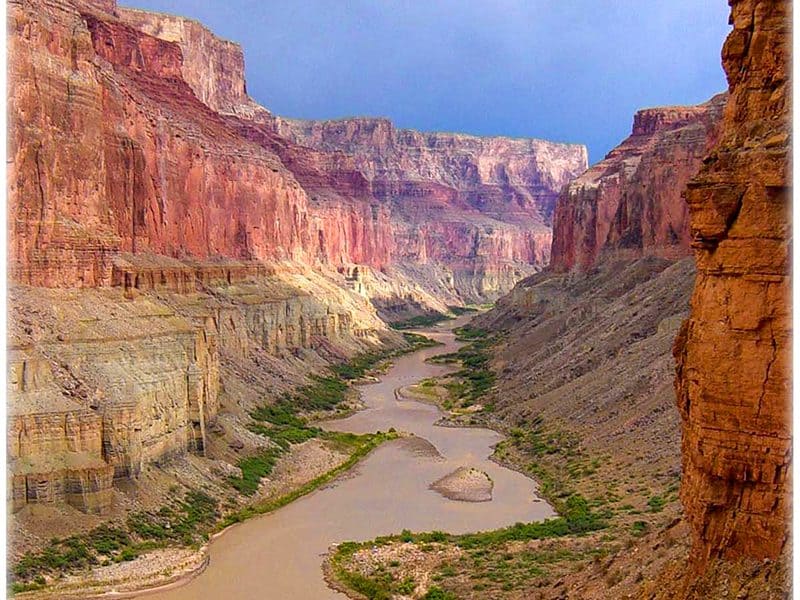
Estimated reading time: 18 minutes
By Jim Ferri
Millions of travelers visit UNESCO World Heritage Sites every year. Scattered all over the world, they are cultural or natural sites that have outstanding value to humanity.

While many Americans travelers are part of this immense World-Heritage-seeking group, relatively few realize we also have many UNESCO sites in the USA. In fact, with an additional two U.S. sites recently added, there are now a total of two dozen sites in the USA.
Worldwide, UNESCO sites range from the well known – the Cathedral of Notre-Dame in France, the Historic City of Ayutthaya in Thailand, the Tower of London in England, for example – to such lesser-known places as the Matobo Hills in Zimbabwe, East Rennell in the Solomon Islands and the Struve Geodetic Arc in Moldova.
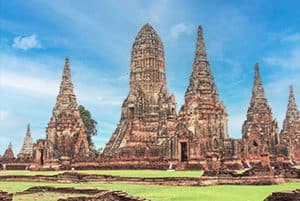
You may not have heard of many of them but they are all exceptional places that need protection for future generations.
Today there are more than 1100 designated sites on the World Heritage List in 161 countries, many of which are of exceptional interest to travelers.
The following is a roundup of the 24 UNESCO World Heritage Sites in the USA that you’ll find closer to home.
They also include the date of their inclusion on the list, as well as GPS coordinates to map your trip, since most people will likely visit by car, perhaps on a enjoyable road trip. All are listed by their region in the USA.
Table of Contents
- UNESCO World Heritage Sites in the Eastern USA
- UNESCO World Heritage Sites in the Midwest USA
- UNESCO World Heritage Sites in the Southern USA
- UNESCO World Heritage Sites in the Southwest USA
- UNESCO World Heritage Sites in the Western USA
- UNESCO World Heritage Sites in Alaska and Hawaii USA
- UNESCO World Heritage Sites in Puerto Rico USA
UNESCO World Heritage Sites in the Eastern USA
Independence Hall (1979)
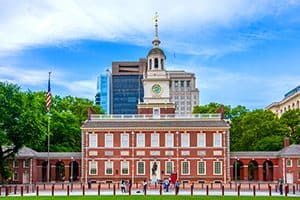
America’s Independence Hall is certainly the centerpiece of Independence National Historical Park in Philadelphia. Both the Declaration of Independence (1776) and the Constitution of the United States (1787) originated in this building. The universal principles of freedom and democracy outlined in these documents are of fundamental importance to American history and have also had a profound impact on lawmakers worldwide.
- Location: Chestnut Street between 5th and 6th Streets in downtown Philadelphia.
- GPS: N39 56 55 W75 9 0
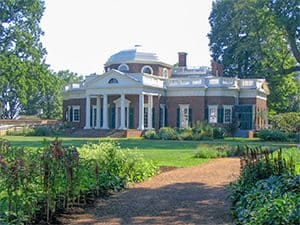
Monticello and the University of Virginia in Charlottesville (1987)
Thomas Jefferson (1743–1826), author of the American Declaration of Independence and the third president of the United States, was also a talented architect of neoclassical buildings. He designed Monticello (1769–1809), his plantation home, and his ideal ‘academical village’ (1817–26), which is still the heart of the University of Virginia.
Additionally, Jefferson’s use of an architectural vocabulary based upon classical antiquity symbolizes the aspirations of the new American republic as the inheritor of European tradition and the cultural experimentation that could be expected as the country matured.
- Location: central Virginia, 70 miles northwest of Richmond.
- GPS: N38 1 58 W78 30 14
Statue of Liberty (1984)
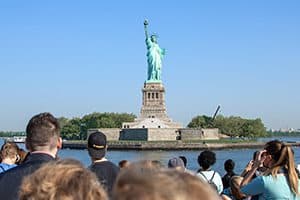
The world-renowned Statue of Liberty was made in Paris by the French sculptor Bartholdi. It was also built in collaboration with Gustave Eiffel who was responsible for the steel framework. Their masterpiece, ”The Statue of Liberty Enlightening the World,” was a gift of friendship from France to the United States. It is still a universal symbol of freedom and democracy.
Despite Liberty Island only being reachable by ferry, approximately 3.5 million people visit the Statue every year.
- Location: at the entrance to New York Harbor.
- GPS: N40 41 22 W74 2 41
Great Smoky Mountains National Park (1983)

Encompassing almost a half-million acres, this exceptionally beautiful park is home to more than 3,500 plant species. It also has almost as many trees (130 natural species) as is found in all of Europe.
Many endangered animal species also survive there, including what is probably the greatest variety of salamanders in the world. Surprisingly to many, it is America’s most visited national park.
- Location: Great Smoky Mountains National Park straddles the border between North Carolina and Tennessee.
- GPS: N35 35 35 W83 26 8
The 20th-Century Architecture of Frank Lloyd Wright (2019) (Multi-Region)

The entire site consists of eight buildings designed by the architect during the first half of the 20th century. These include well-known designs such as Fallingwater (Mill Run, Pennsylvania) and the Guggenheim Museum (New York).
All the buildings also reflect the ‘organic architecture’ developed by Wright, which blurs the boundaries between exterior and interior and the unprecedented use of steel and concrete. Each offers innovative housing, worship, work, or leisure solutions. Additionally, Wright’s work from this period substantially impacted the development of modern architecture in Europe.
- Location: various, including Mill Run, Pennsylvania, and New York City.
- GPS: N39 54 20.055 W79 27 59.312 (Mill Run, PA)
UNESCO World Heritage Sites in the Midwest USA
Cahokia Mounds State Historic Site (1982)
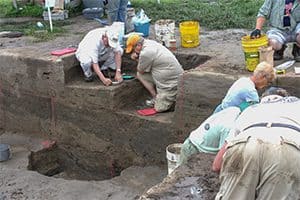
One of the great cities of the world, Cahokia Mounds is the largest pre-Colombian settlement north of Mexico. In fact, Cahokia was larger than London in AD 1250. It was occupied primarily during the Mississippian period (800–1400), when it covered nearly 4,000 acres and included some 120 mounds.
Equally important, it is a striking example of a complex chiefdom society, with many satellite mound centers and numerous outlying hamlets and villages. Incredibly, this agricultural society may also have had a population of 10–20,000 at its peak between 1050 and 1150. Primary features at the site include Monks Mound, the largest prehistoric earthwork in the Americas, covering over 5 ha and standing 30m high.
- Location: about 8 miles northeast of St Louis, in Collinsville, Illinois off Interstates 55/70 and 255.
- GPS: N38 39 31 W90 3 41
UNESCO World Heritage Sites in the Southern USA
Monumental Earthworks of Poverty Point (2014)
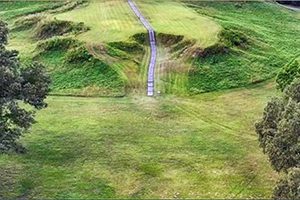
The Monumental Earthworks of Poverty Point owes its name to a 19th-century plantation close to the site in the Lower Mississippi Valley on a slightly elevated and narrow land form.
The complex comprises five mounds, six concentric semi-elliptical ridges separated by shallow depressions, and also a central plaza. It was created and used for residential and ceremonial purposes by a society of hunter-fisher-gatherers between 3700 and 3100 BP.
It is a remarkable achievement in earthen construction in North America that was unsurpassed for at least 2,000 years.
- Location: northeastern Louisiana.
- GPS: N32 38 13 W91 24 23
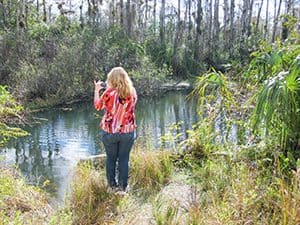
Everglades National Park (1979)
Without a doubt Everglades National Park is the largest subtropical wilderness in the United States, It protects an unparalleled landscape that provides important habitat for numerous rare and endangered species including the manatee, American crocodile, and the elusive Florida panther.
It is an enormous and beautiful National Park, which you must visit to appreciate.
- Location: at the southern tip of Florida.
- GPS: N25 33 16 W80 59 47
Mammoth Cave National Park (1981)
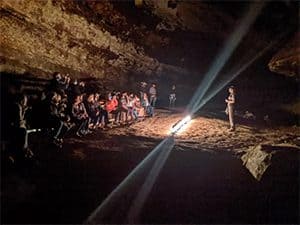
Mammoth Cave National Park preserves the cave system and a part of the Green River valley and hilly country of south central Kentucky. It’s the world’s longest known cave system, with more than 400 miles explored, and home to a varied flora and fauna, including a number of endangered species.
- Location: in south central Kentucky about 90 miles south of Louisville.
- GPS: N37 11 14 W86 6 11
UNESCO World Heritage Sites in the Southwest USA
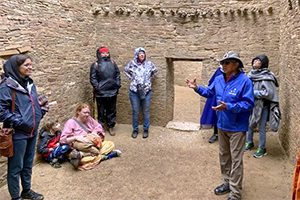
Chaco Culture (1987)
For over 2,000 years, the Pueblo people occupied a vast region of southwestern North America in what is now New Mexico. Chaco Canyon, a major center of ancestral Pueblo culture between 850 and 1250, was unquestionably a focus for ceremonials, trade, and political activity for the prehistoric Four Corners area.
Chaco is remarkable for its monumental public and ceremonial buildings and distinctive architecture – it has an ancient urban ceremonial center unlike anything constructed before or since. In addition to the Chaco Culture National Historical Park, the World Heritage property includes the Aztec Ruins National Monument and several smaller Chaco sites managed by the Bureau of Land Management.
- Location: in northwestern New Mexico, between Albuquerque and Farmington, in a remote canyon cut by the Chaco Wash.
- GPS: N36 3 49.6 W107 58 15
San Antonio Missions (2015)
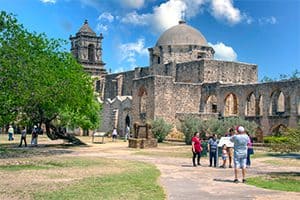
The site encompasses a group of five frontier mission complexes situated along a stretch of the San Antonio River basin about a 12-mile drive south of San Antonio. Significantly, it includes architectural complexes built by Franciscan missionaries in the 18th century. They illustrate the Spanish Crown’s efforts to colonize, evangelize and defend the northern frontier of New Spain. The San Antonio Missions are also an example of the interweaving of Spanish and Coahuiltecan cultures.
- Location: a twenty-minute drive south of San Antonio.
- GPS: N29 19 41 W98 27 36
Mesa Verde National Park (1978)
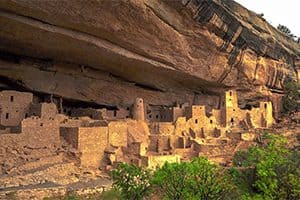
A significant concentration of ancestral Pueblo Indian dwellings, built from the 6th to the 12th century, can be found on the Mesa Verde plateau in southwest Colorado at more than 2,600 m altitude.
Some 4,400 sites, including villages built on the Mesa top, have been recorded. There are also imposing cliff dwellings made of stone and comprising more than 100 rooms.
- Location: southwest Colorado.
- GPS: N37 15 42 W108 29 8
Taos Pueblo (1992)

Representing the culture of the Pueblo Indians of Arizona and New Mexico, Taos Pueblo is the only living Native American community designated both a World Heritage Site by UNESCO and a National Historic Landmark.
Its multi-storied adobe buildings have been continuously inhabited for over 1000 years.
- Location: about 1 ½ hours north of Santa Fe.
- GPS: N36 26 20.004 W105 32 30.012
Grand Canyon National Park (1979)
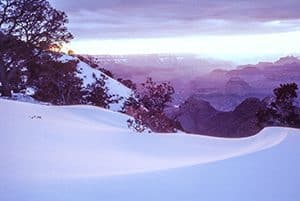
A powerful and inspiring landscape, the remarkable Grand Canyon was carved out by the Colorado River. Without a doubt,it is the most spectacular gorge in the world.
Its horizontal strata also retrace the geological history of the past 2 billion years. There are also prehistoric traces of human adaptation to a particularly harsh environment.
- Location: northern Arizona.
- GPS: N36 6 3 W112 5 26
Carlsbad Caverns National Park (1995)
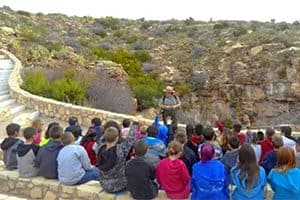
Beneath a rugged land of rocky slopes and canyons, cactus, grass, thorny shrubs and the occasional tree, is the hidden treasure of Carlsbad Caverns deep underground. The are numerous and outstanding not only for their size but also for the profusion, diversity and beauty of their mineral formations.
- Location: southeast New Mexico, near the border of Texas.
- GPS: N32 10 0 W104 22 60
UNESCO World Heritage Sites in the Western USA

Olympic National Park (1981)
Located in the northwest of Washington State, Olympic National Park is certainly renown for the diversity of its ecosystems. Glacier-clad peaks interspersed with extensive alpine meadows surround a vast old-growth forest, the best example of intact and protected temperate rain forest in the Pacific Northwest. Altogether, eleven major river systems drain the Olympic mountains, offering some of the country’s best habitats for anadromous fish species.
The park also includes 60 miles (100 km) of wilderness coastline, the longest undeveloped coast in the contiguous United States. It is rich in native and endemic animal and plant species, including critical populations of the endangered northern spotted owl, marbled murrelet, and bull trout.
- Location: northwest Washington State.
- GPS: N47 44 54 W123 26 56
Redwood National and State Parks (1980)
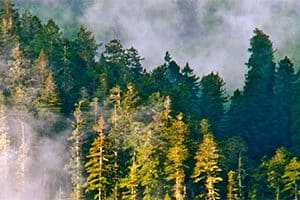
Redwood National Park comprises a region of coastal mountains bordering the Pacific Ocean north of San Francisco. It is covered with a magnificent forest of coastal redwood trees, the tallest and most impressive trees in the world. The marine and land life are equally remarkable, particularly the sea lions, the bald eagle, and the endangered California brown pelican.
- Location: along the Pacific Coast north of San Francisco.
- GPS: N41 22 26 W123 59 53
Waterton Glacier International Peace Park (1995)
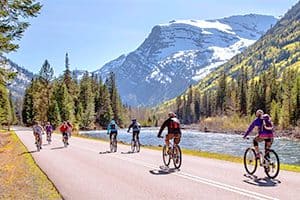
In 1932 Waterton Lakes National Park (Alberta, Canada) was combined with Glacier National Park (Montana, United States) to form the world’s first International Peace Park. Since it is siituated on the border between the two countries and offers outstanding scenery, the park is exceptionally rich in plant and mammal species, prairie, forest, and alpine and glacial features.
- Location: on the U.S.-Canada border in Montana.
- GPS: N48 59 45.8 W113 54 15
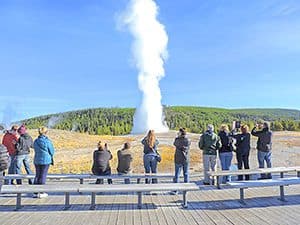
Yellowstone National Park (1978)
The vast natural forest of Yellowstone National Park covers nearly 9,000 km2; 96% of the park lies in Wyoming, 3% in Montana, and 1% in Idaho. Yellowstone contains half of all the world’s known geothermal features, with more than 10,000 examples. It also has the world’s largest concentration of geysers (more than 300 years, or two-thirds of all those on the planet).
Established in 1872, Yellowstone is equally known for its wildlife, such as grizzly bears, wolves, bison, and wapitis. Yellowstone is a great place for a family vacation.
- Location: 96% of the park lies in Wyoming, 3% in Montana and 1% in Idaho.
- GPS: N44 27 38.016 W110 49 40.008
Yosemite National Park (1984)
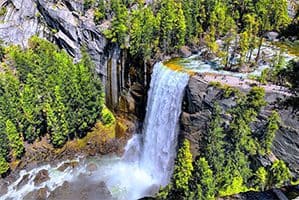
Beautiful Yosemite National Park lies in the heart of California. Its ‘hanging’ valleys, many waterfalls, cirque lakes, polished domes, moraines, and U-shaped valleys provide an excellent overview of granite relief fashioned by glaciation.
At 600–4,000m, you’ll also find a great variety of flora and fauna here. It is an exceptionally popular and beautiful U.S. National Park that is world renowned.
- Location: about 3 ½ hours east of San Francisco.
- GPS: N37 44 46 W119 35 48
UNESCO World Heritage Sites in Alaska and Hawaii USA
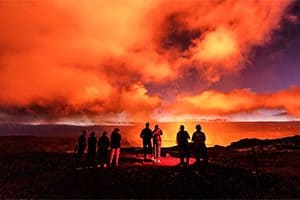
Hawaii Volcanoes National Park (1987)
The Hawaii Volcanoes National Park contains two of the most active volcanoes in the world, Mauna Loa (more than 13,000 feet high) Hawaii and Kilauea (4,100 feet high), both of which tower over the Pacific Ocean.
Volcanic eruptions have also created a constantly changing landscape, and the lava flows reveal surprising geological formations.
- Location: on the island of Hawaii.
- GPS: N19 24 3 W155 7 25
Kluane / Wrangell-St. Elias / Glacier Bay / Tatshenshini-Alsek (1979)

These parks comprise an impressive complex of glaciers and high peaks on both sides of the border between Canada (Yukon Territory and British Columbia) and the United States (Alaska). The spectacular natural landscapes are home to many grizzly bears, caribou, and Dall’s sheep.
In addition, the site contains the largest non-polar ice field in the world.
- Location: southeast Alaska.
- GPS: N61 11 51.3 W140 59 31.1
Papahanaumokuakea (2010)
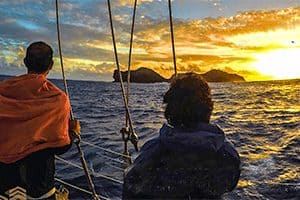
Papahānaumokuākea is a vast and isolated linear cluster of small, low-lying islands and atolls, with their surrounding ocean roughly 250 km to the northwest of the central Hawaiian Archipelago and extending over some 1931 km. Not surprisingly, the area has deep cosmological and traditional significance for living Native Hawaiian culture as an ancestral environment, the embodiment of the Hawaiian concept of kinship between people and the natural world, and where it is believed that life originates and where the spirits return after death.
On two islands, Nihoa and Makumanamana, archaeological remains relate to pre-European settlement and use. Much of the monument comprises pelagic and deep-water habitats, with notable features such as seamounts, submerged banks, extensive coral reefs, and lagoons. It is one of the world’s largest marine protected areas (MPAs).
- Location: Papahanaumokuakea is located approximately 150 miles to the northwest of the main Hawaiian Islands.
- GPS: N25 20 56.652 W170 8 44.952
UNESCO World Heritage Sites in Puerto Rico USA
La Fortaleza and San Juan National Historic Site (1983)
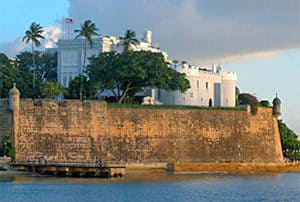
Between the 16th and 20th centuries, a series of defensive structures was built in present-day San Juan, Puerto Rico, at this strategic point in the Caribbean Sea to protect the city and the Bay of San Juan. Altogether they represent a fine display of European military architecture adapted to harbor sites on the American continent.
- Location: San Juan (the current official residence of the Governor of Puerto Rico).
- GPS: N18 28 0 W66 7 30
You may also enjoy: Most Visited Attractions in the USA / Why Yellowstone Is Perfect for a Family Vacation / Things to Do in Cody, WY, Where the Old American West Is Still Alive

This all is great, helpful information for us readers and travelers to know! Thank you.